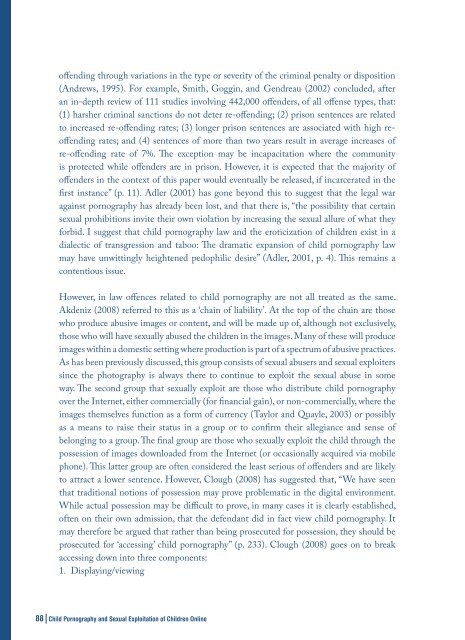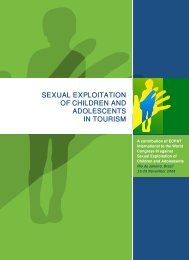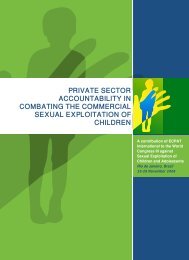to download the document in PDF format - Child Centre: Expert ...
to download the document in PDF format - Child Centre: Expert ...
to download the document in PDF format - Child Centre: Expert ...
You also want an ePaper? Increase the reach of your titles
YUMPU automatically turns print PDFs into web optimized ePapers that Google loves.
offend<strong>in</strong>g through variations <strong>in</strong> <strong>the</strong> type or severity of <strong>the</strong> crim<strong>in</strong>al penalty or disposition(Andrews, 1995). For example, Smith, Gogg<strong>in</strong>, and Gendreau (2002) concluded, afteran <strong>in</strong>-depth review of 111 studies <strong>in</strong>volv<strong>in</strong>g 442,000 offenders, of all offense types, that:(1) harsher crim<strong>in</strong>al sanctions do not deter re-offend<strong>in</strong>g; (2) prison sentences are related<strong>to</strong> <strong>in</strong>creased re-offend<strong>in</strong>g rates; (3) longer prison sentences are associated with high reoffend<strong>in</strong>grates; and (4) sentences of more than two years result <strong>in</strong> average <strong>in</strong>creases ofre-offend<strong>in</strong>g rate of 7%. The exception may be <strong>in</strong>capacitation where <strong>the</strong> communityis protected while offenders are <strong>in</strong> prison. However, it is expected that <strong>the</strong> majority ofoffenders <strong>in</strong> <strong>the</strong> context of this paper would eventually be released, if <strong>in</strong>carcerated <strong>in</strong> <strong>the</strong>first <strong>in</strong>stance” (p. 11). Adler (2001) has gone beyond this <strong>to</strong> suggest that <strong>the</strong> legal waraga<strong>in</strong>st pornography has already been lost, and that <strong>the</strong>re is, “<strong>the</strong> possibility that certa<strong>in</strong>sexual prohibitions <strong>in</strong>vite <strong>the</strong>ir own violation by <strong>in</strong>creas<strong>in</strong>g <strong>the</strong> sexual allure of what <strong>the</strong>yforbid. I suggest that child pornography law and <strong>the</strong> eroticization of children exist <strong>in</strong> adialectic of transgression and taboo: The dramatic expansion of child pornography lawmay have unwitt<strong>in</strong>gly heightened pedophilic desire” (Adler, 2001, p. 4). This rema<strong>in</strong>s acontentious issue.However, <strong>in</strong> law offences related <strong>to</strong> child pornography are not all treated as <strong>the</strong> same.Akdeniz (2008) referred <strong>to</strong> this as a ‘cha<strong>in</strong> of liability’. At <strong>the</strong> <strong>to</strong>p of <strong>the</strong> cha<strong>in</strong> are thosewho produce abusive images or content, and will be made up of, although not exclusively,those who will have sexually abused <strong>the</strong> children <strong>in</strong> <strong>the</strong> images. Many of <strong>the</strong>se will produceimages with<strong>in</strong> a domestic sett<strong>in</strong>g where production is part of a spectrum of abusive practices.As has been previously discussed, this group consists of sexual abusers and sexual exploiterss<strong>in</strong>ce <strong>the</strong> pho<strong>to</strong>graphy is always <strong>the</strong>re <strong>to</strong> cont<strong>in</strong>ue <strong>to</strong> exploit <strong>the</strong> sexual abuse <strong>in</strong> someway. The second group that sexually exploit are those who distribute child pornographyover <strong>the</strong> Internet, ei<strong>the</strong>r commercially (for f<strong>in</strong>ancial ga<strong>in</strong>), or non-commercially, where <strong>the</strong>images <strong>the</strong>mselves function as a form of currency (Taylor and Quayle, 2003) or possiblyas a means <strong>to</strong> raise <strong>the</strong>ir status <strong>in</strong> a group or <strong>to</strong> confirm <strong>the</strong>ir allegiance and sense ofbelong<strong>in</strong>g <strong>to</strong> a group. The f<strong>in</strong>al group are those who sexually exploit <strong>the</strong> child through <strong>the</strong>possession of images <strong>download</strong>ed from <strong>the</strong> Internet (or occasionally acquired via mobilephone). This latter group are often considered <strong>the</strong> least serious of offenders and are likely<strong>to</strong> attract a lower sentence. However, Clough (2008) has suggested that, “We have seenthat traditional notions of possession may prove problematic <strong>in</strong> <strong>the</strong> digital environment.While actual possession may be difficult <strong>to</strong> prove, <strong>in</strong> many cases it is clearly established,often on <strong>the</strong>ir own admission, that <strong>the</strong> defendant did <strong>in</strong> fact view child pornography. Itmay <strong>the</strong>refore be argued that ra<strong>the</strong>r than be<strong>in</strong>g prosecuted for possession, <strong>the</strong>y should beprosecuted for ‘access<strong>in</strong>g’ child pornography” (p. 233). Clough (2008) goes on <strong>to</strong> breakaccess<strong>in</strong>g down <strong>in</strong><strong>to</strong> three components:1. Display<strong>in</strong>g/view<strong>in</strong>g88|<strong>Child</strong> Pornography and Sexual Exploitation of <strong>Child</strong>ren Onl<strong>in</strong>e




